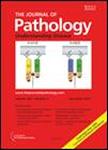版权所有:内蒙古大学图书馆 技术提供:维普资讯• 智图
内蒙古自治区呼和浩特市赛罕区大学西街235号 邮编: 010021

作者机构:Biodonostia Res Inst Oncol Area San Sebastian 20014 Spain Univ Oxford Nuffield Dept Clin Lab Sci Oxford OX1 2JD England Basque Fdn Sci IKERBASQUE Bilbao Spain Univ Basque Country UPV EHU Sch Nursing Leioa Bizkaia Spain Charles Univ Hosp Dept Pathol Plzen Czech Republic Cruces Univ Hosp Dept Urol Baracaldo Bizkaia Spain Univ Basque Country UPV EHU BioCruces Res Inst Cruces Univ Hosp Dept Pathol Baracaldo Bizkaia Spain
出 版 物:《JOURNAL OF PATHOLOGY》 (病理学杂志)
年 卷 期:2014年第232卷第1期
页 面:32-42页
核心收录:
学科分类:1002[医学-临床医学] 1001[医学-基础医学(可授医学、理学学位)] 10[医学]
基 金:Starmer-Smith memorial fund Ministerio de Economia y Competitividad Consejeria de Industria Comercio y Turismo del Gobierno Vasco Asociacion Espanola Contra el Cancer (AECC) Diputacion Foral de Gipuzkoa
主 题:miRNA non-coding RNA EMT renal carcinoma clear cell papillary renal cell carcinoma
摘 要:Clear cell tubulopapillary renal cell carcinoma (CCPRCC) is a recently described rare renal malignancy that displays characteristic gross, microscopic and immunohistochemical differences from other renal tumour types. However, CCPRCC remains a very poorly understood entity. We therefore sought to elucidate some of the molecular mechanisms involved in this neoplasm by carrying out targeted next-generation sequencing (NGS) to identify associated mutations, and in addition examined the expression of non-coding (nc) RNAs. We identified multiple somatic mutations in CCPRCC cases, including a recurrent [3/14 cases (21%)] non-synonymous T992I mutation in the MET proto-oncogene, a gene associated with epithelial-to-mesenchymal transition (EMT). Using a microarray approach, we found that the expression of mature (n = 1105) and pre-miRNAs (n = 1105), as well as snoRNA and scaRNAs (n = 2214), in CCPRCC cases differed from that of clear cell renal cell carcinoma (CCRCC) or papillary renal cell carcinoma (PRCC) tumours. Surprisingly, and unlike other renal tumour subtypes, we found that all five members of the miR-200 family were over-expressed in CCPRCC cases. As these miRNAs are intimately involved with EMT, we stained CCPRCC cases for E-cadherin, vimentin and -catenin and found that the tumour cells of all cases were positive for all three markers, a combination rarely reported in other renal tumours that could have diagnostic implications. Taken together with the mutational analysis, these data suggest that EMT in CCPRCC tumour cells is incomplete or blocked, consistent with the indolent clinical course typical of this malignancy. In summary, as well as describing a novel pathological mechanism in renal carcinomas, this study adds to the mounting evidence that CCPRCC should be formally considered a distinct entity. Microarray data have been deposited in the GEO database [GEO accession number (GSE51554)]. Copyright (c) 2013 Pathological Society of Great Britain and Ireland. P